Heitjans P., Karger J. (Eds.). Diffusion in Condensed Matter: Methods, Materials, Models
Подождите немного. Документ загружается.


762 Klaus W. Kehr et al.
periodic force. Equivalently, one may define a frequency-dependent diffusion
coefficient as the Fourier transform of the velocity autocorrelation function
of the particle. The connection with the s-dependent effective rate is (a =1)
D(ω)=Re[
˜
Γ
eff
(s =iω)] (18.64)
and comparison with (18.60) shows that
D(ω)=Γ
eff
(1 + ϑ
1
(ω/Γ
eff
)
1/2
+ ···) ω −→ 0 . (18.65)
Hence one finds a strong increase of the diffusion coefficient and the mobility
with frequency, for small frequencies.
18.3.5 Higher-Dimensional Lattices: Approximations
Approximations are generally necessary when one treats diffusion of single
particles on higher-dimensional lattices. An exception is the random site-
energy model, where the diffusion coefficient is known exactly in all dimen-
sions [15, 30]. First the effective-medium approximation (EMA) will be dis-
cussed; this is an approximation that includes frequency dependence. As al-
ready said in the introduction, the EMA replaces the disordered medium
by an effective ordered medium. A candid criticism of the philosophy of the
EMA from the point of view of a theorist has been given by Anderson [4].
Nonetheless, EMA provides an adequate overall description of various disor-
dered systems.
Effective-Medium Approximation
The embedding procedure for one random bond described in the previous sec-
tion can be extended to higher dimensions. The result is the self-consistency
condition [37]
˜
Γ
eff
(s) − Γ
z−2
2
˜
Γ
eff
(s)+Γ + s
˜
E
0
(s)[
˜
Γ
eff
(s) − Γ ]
ρ(Γ )
=0. (18.66)
The relevant parameter is z, the coordination number; z =2d for hypercubic
lattices. The conditional probability for the effective medium
˜
E
0
(s)ismore
complicated for d>1thanind = 1. To obtain the static, long-time diffusion
coefficient one has to set s = 0. The product s
˜
E
0
(s) vanishes for s =0inall
d and the self-consistency condition reduces to
Γ
eff
− Γ
z−2
2
Γ
eff
+ Γ
ρ(Γ )
=0. (18.67)
This self-consistency condition was already established by Kirkpatrick [39]
who considered the equivalent problem of random resistor networks. If the

18 Diffusion of Particles on Lattices 763
effective transition rate has been determined, the diffusion coefficient is given
by D = Γ
eff
a
2
in hypercubic lattices.
The average in (18.67) can be evaluated explicitly for a uniform distrib-
ution of activation energies [40],
ν
B
(E)=
1
E
c
0 ≤ E ≤ E
c
0otherwise.
(18.68)
One finds for E
c
k
B
T and z>2
Γ
eff
−→
2Γ
0
z − 2
exp
−
2E
c
zk
B
T
. (18.69)
The EMA result for the simple-square lattice is then
Γ
eff
−→ Γ
0
exp
−
E
c
2k
B
T
, (18.70)
and the one for the simple-cubic lattice
Γ
eff
−→
Γ
0
2
exp
−
E
c
3k
B
T
. (18.71)
Good agreement with numerical simulations has been found [41, 42]. Fig-
ure 18.6 shows simulation results [42] for the mean square displacement of
particles on a simple-square lattice with random barriers. One observes pro-
nounced transient behaviour for stronger disorder at intermediate times, until
the asymptotic behaviour is reached. Good agreement with the predicted as-
ymptotic behaviour (18.70) is recognized.
Critical-Path Approach
For very large disorder or very low temperatures, the diffusion coefficient of
the RB model can be estimated by the critical-path approach. This intu-
itive method was proposed by Shklovskii and Efros [43] and by Ambegaokar,
Halperin, and Langer [44]. Consider a large but finite d-dimensional lattice
and decorate the bonds with random hopping rates. Identify the largest hop-
ping rate on the lattice, then the second largest rate, etc. (see Fig. 18.7).
Continue until a connection between two opposite sides of the (large)
lattice is obtained. In the limit N −→ ∞ the possibility of connection defines
the bond percolation threshold [45], see also Chap. 22. The smallest rate in
the set of all selected rates represents an estimate for the diffusion coefficient.
The activation energy for the smallest rate will be determined for the
uniform distribution of activation energies. Evidently (cf. Fig. 18.8)
E
∗
0
dEν
B
(E)=p
c
. (18.72)
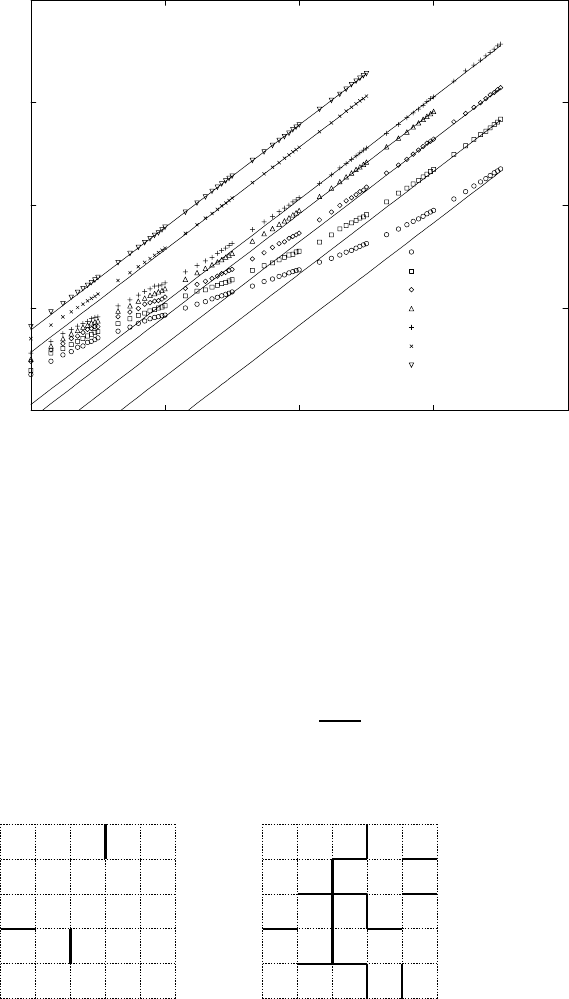
764 Klaus W. Kehr et al.
10
0
10
2
10
4
10
6
10
8
time [MCS]
10
-2
10
0
10
2
10
4
10
6
<R(t)
2
>
T = 0.05
T = 0.065
T = 0.08
T = 0.10
T = 0.115
T = 0.25
T = 0.50
Fig. 18.6. Mean square displacement of particles in the RB model in d =2asa
function of time. Lines: (18.70); symbols: MC simulations. Uniform distributions of
activation energies; T is given in units of E
c
/2. From [42].
For the uniform distribution one obtains
E
∗
= p
c
E
c
. (18.73)
Hence the estimate for the diffusion coefficient is
D
∼
=
Γ
0
exp
−
p
c
E
c
k
B
T
. (18.74)
(a) (b)
Ε
*
Ε
*
Fig. 18.7. Construction of the critical path: (a) the three largest transition rates
are identified; a percolating path has been closed by bond with barrier E
∗
.
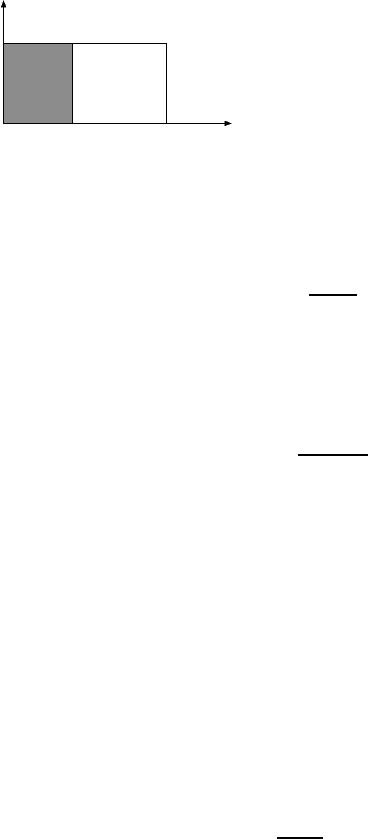
18 Diffusion of Particles on Lattices 765
ν
(E)
B
EE
*
E
c
Fig. 18.8. Determination of the barrier E
∗
from density of states.
In d = 2 the bond percolation threshold is p
c
=0.5 and one has
D
∼
=
Γ
0
exp
−
E
c
2k
B
T
. (18.75)
This result is identical to the EMA result (18.70). In fact, it is an exact
result, as was shown by Bernasconi et al. using the self-duality of the square
lattice [46]. In d =3,wherep
c
≈ 0.244 one obtains
D
∼
=
Γ
0
exp
−
0.244E
c
k
B
T
, (18.76)
i. e. a result that is different from the EMA result. As said above it gives the
dominant behaviour for very low temperatures or very strong disorder, but
there are important corrections to it [47,48].
Single Particles in the RBS Model
The diffusion of single particles in lattices with randomly blocked sites be-
longs to the same category of problems as other diffusion models on disordered
lattices. However, the methods of treatment are somewhat different. As al-
ready said, only low concentrations p of blocked sites will be considered, such
that long-range diffusion of test particles is always possible. An approximate
derivation of the diffusion coefficient was made by Tahir-Kheli [49] and his
result is (a =1)
D = Γ
0
1 −
1 − p
f
+ ···
. (18.77)
In the formula the correlation factor f for tracer diffusion in lattice gases ap-
pears, which will be discussed in Sect. 18.4.3. Ernst et al. [50] could establish
(18.77) by performing a perturbation expansion with respect to 1 − p.
The validity of (18.77) was investigated by numerical simulations in
simple-cubic lattices [51] and it was found that it is a good approximation
for small and moderate concentrations of blocked sites, see Fig. 18.9.
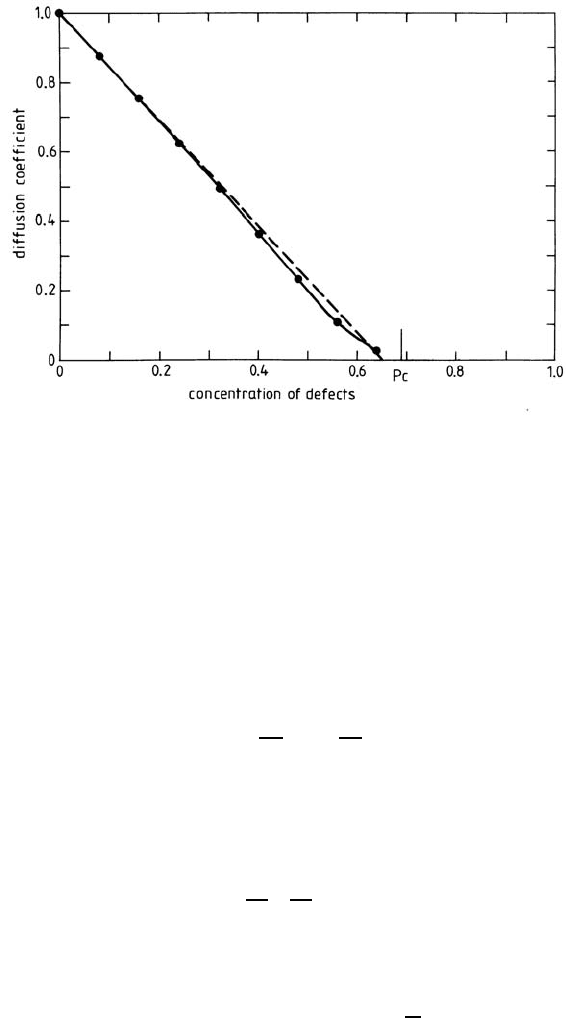
766 Klaus W. Kehr et al.
Fig. 18.9. Diffusion coefficient of single particles in the RBS model, as a function
of the concentration of blocked sites. Symbols: MC simulations; continuous line:
spline fit to the MC results; dashed line: (18.77). From [51].
18.3.6 Higher-Dimensional Lattices: Applications
Vanishing of D for Exponentially Distributed Site Energies
An interesting application of the exact result (18.46) for the RT model in
arbitrary dimensions can be made for the exponential energy distribution.
This distribution is given by
ν
T
(E)=
1
E
c
exp
E
E
c
E ≤ 0 . (18.78)
Combining this expression with the Arrhenius law (18.30) for the transition
rates of the RT model, one can calculate the distribution of transition rates
ρ(Γ ) (this is equivalent to a change of the integration variable from E to Γ ),
ρ(Γ )=
α
Γ
0
Γ
Γ
0
α−1
,Γ≤ Γ
0
, (18.79)
where α = k
B
T/E
c
. The inverse of the diffusion coefficient is then given by
(a =1)
D
−1
=
Γ
0
0
dΓρ(Γ )
1
Γ
. (18.80)
D
−1
diverges for α<1, and consequently

18 Diffusion of Particles on Lattices 767
D ≡ 0forα<1 . (18.81)
Hence the diffusion coefficient vanishes for random site energies with an ex-
ponential distribution, for temperatures k
B
T ≤ E
c
, in arbitrary dimensions.
The mean square displacement of particles does no longer exhibit linear
behaviour at long times for α<1. Instead one finds subdiffusive behaviour,
as was derived by Havlin, Trus, and Weiss [52]:
R
2
(t) ∼
t
2α
α+1
d =1
t
α
d ≥ 2 .
(18.82)
Combined RB and RT Model for d>1
How can one treat more general models with disorder by approximations
in higher dimensions? The EMA as formulated above with one systematic
bond requires symmetric rates. A hint can be obtained from the exact result
(18.43) for generally disordered rates in d = 1. The message of this result is:
Use thermally weighted transition rates Γ
ji
ρ
i
for the general models. Invoking
the relation of detailed balance,
Γ
ji
ρ
i
= Γ
ij
ρ
j
, (18.83)
one observes that the thermally weighted rates are symmetric, hence they
canbeemployedintheEMAasformulatedabove.
The utilization of thermally weighted transition rates will be illustrated
for the combined RB and RT model. Its rates were given in (18.31) and the
weighted rates were already given in (18.48). From the self-consistency con-
dition (18.67) follows for independent barriers and site-energies in arbitrary
dimensions [31]
D
EMT
comb
=
1
Γ
0
D
EMT
RB
D
RT
. (18.84)
Since D
RT
is known exactly, cf. (18.46), only the application of the EMA for
the random barriers is necessary [31].
The interest in the combined RB and RT model originates from experi-
ments on diffusion in amorphous metallic alloys. The diffusion coefficient in
these substances exhibits typically linear behaviour in an Arrhenius plot of
ln D vs. ln 1/T . This is not expected from the simple models for diffusion in
disordered lattices.
As was discussed in Sect. 18.3.3, the RT model exhibits downward cur-
vature in an Arrhenius plot of ln D versus ln 1/T (i. e. the deepest trap sites
dominate at low temperatures). In contrast, the RB model exhibits upward
curvature in an Arrhenius plot of ln D vs. ln 1/T for z>4. One can give the
following argument for the origin of this upward curvature: The critical path
dominates the behaviour of the diffusion coefficient at the lowest tempera-
ture; additional paths contribute at higher temperatures and they comprise
higher activation energies.
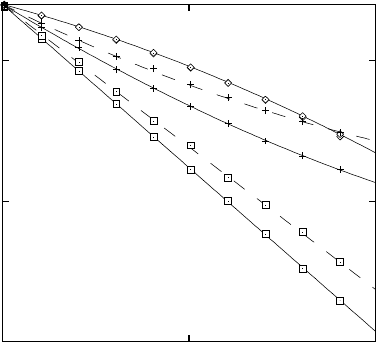
768 Klaus W. Kehr et al.
-0.2
-0.7
-1.2
012
1/T
ln(D)
Fig. 18.10. Arrhenius plot of the diffusion coefficient for two-level models. Con-
tinuous lines: EMA, d =3;dashedlines:EMA,d =5.Symbols:MCresults(+:RB
model, :RTmodel,2: combined model).
Limoge and Bocquet suggested a possible compensation of the effects of
random barriers and of random traps [53]. The original derivations given
in [53] were only partially satisfactory. We investigated the problem by the
analytic approach outlined above and by numerical simulations [54]. This
reference also contains a more detailed discussion of the previous work. It
was found that compensation is possible in finite temperature intervals if
the relative strengths of RB and RT are properly adjusted. Fig. 18.10 shows
this compensation for uniform distributions of barrier and trap energies in
d =3when|E
T
c
|≈3/5 E
B
c
. Complete compensation of the curvature is only
possible for d −→ ∞, as was shown by Wichmann [29].
Frequency Dependence
Only some remarks on the frequency dependence of the mobility or the dif-
fusion coefficient will be made. There are many observations of frequency-
dependent conductivities in disordered substances with typically
σ(ω) ∼ ω
β
0 <β<1 . (18.85)
The question is whether this behaviour can be understood in the framework of
single-particle theories, for instance by EMA. So far, asymptotic results were
derived for the frequency-dependent conductivity in the limit ω → 0 [33], for
18 Diffusion of Particles on Lattices 769
a review, see [15]. They seem to be not really useful in the frequency ranges
of interest. Numerical evaluations of the self-consistency condition for finite
ω were made by Wagener and Schirmacher [55] and Hoerner et al. [56]. The
authors found a frequency dependence in qualitative accord with (18.85).
In the opinion of the authors, no simple physical picture of the origin of
anomalous frequency dependence has been established so far (see however
Chap. 21).
It should also be pointed out that the problem of the frequency-dependent
mobility is truly a many-particle problem, in addition, the particles can have
interactions. Work has been done on this problem mainly by numerical sim-
ulations [57–59], see also Chap. 20.
18.3.7 Remarks on Other Models
In this section some comments will be made concerning several models that
are not treated in this chapter. The first three are addressed in other chapters
of this textbook, hence some cursory remarks will suffice.
Fractals
These objects are considered in Chaps. 10 and 19. If they are regularly con-
structed objects, often an explicit solution of recursion relations is possible,
and the mean square displacement of diffusing particles can be calculated.
Percolation lattice
This model is treated in Chap. 22, together with experimental realizations. It
can be viewed as the RBS model, where the concentration of blocked sites is
adjusted at the threshold value where the diffusion coefficient vanishes. Diffu-
sion of particles on fractals and on percolation lattices exhibits an interesting
behaviour including scaling laws that are different from ordinary diffusion.
Extended defects
Also extended defects are not included in this chapter. An example are grain
boundaries, which are of great practical importance. They are treated in
Chap. 8.
Sinai model
Also here no detailed treatment will be given, only some introductory con-
siderations concerning the one-dimensional model will be presented.
In the Sinai model (see the references in [60]) the transition rates to the
right, Γ
i+1,i
, and to the left, Γ
i−1,i
, are independent random variables with
the restriction
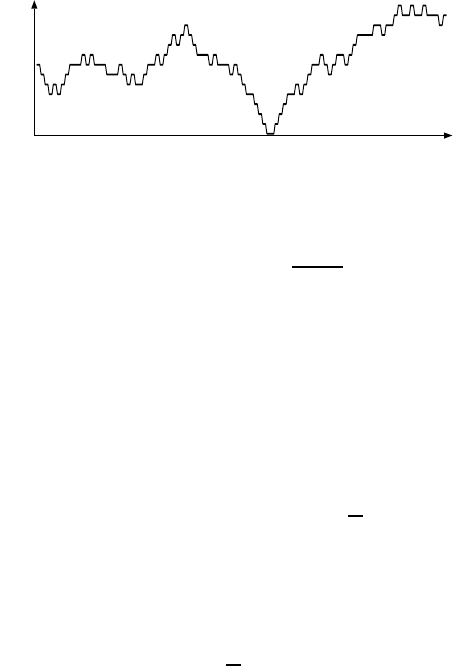
770 Klaus W. Kehr et al.
Position
Energy
Fig. 18.11. Pictorial representation of the Sinai model on a larger scale.
ln
Γ
i+1,i
Γ
i−1,i
=0. (18.86)
The potential that would yield such transition rates from the Arrhenius law
can be imagined as representing a random walk by itself, cf. Fig. 18.11. The
Sinai condition can be interpreted as the requirement that the potential does
not contain additional systematic forces that would induce drift of the particle
in either direction.
An estimate of the behaviour of the mean square displacement can be
given in the following way [60]: Since the potential displayed in Fig. 18.11
represents a random walk, the typical height difference over a length L is
described by
V ∼
√
L. (18.87)
The motion of the particle requires thermal activation, hence the typical time
for a particle to move the length L is
t ∼ exp(V/k
B
T ) . (18.88)
Using (18.87) one finds
√
L ∼ ln t. Hence the typical mean square displace-
ment in this model is given by
δx
2
∼(ln t)
4
. (18.89)
Diffusion of a particle in the Sinai model cannot be treated by the methods
of Sect. 18.3.2, because the condition of existence of the ρ
i
is violated. If one
increases the length of the chain, deeper and deeper valleys appear, in which
the ρ
i
are concentrated. Thus the limit L →∞does not exist for the ρ
i
.In
summary, the Sinai model is theoretically extremely interesting. Its practical
relevance, however, is limited: unbounded variations of the potential are not
physical for real substances.

18 Diffusion of Particles on Lattices 771
18.4 Many Particles on Uniform Lattices
18.4.1 Lattice Gas (Site Exclusion) Model
In the lattice-gas model, sites of a lattice are occupied by particles. Each site
can be occupied by at most one particle. A pictorial representation is given
in Fig. 18.12.
There are many applications of lattice-gas models. Two prominent ex-
amples are hydrogen in metals (see Sect. 3.5 in Chap. 3), where the atoms
occupy interstitial sites of the metal lattice, and impurity atoms on surfaces
of crystals.
The concentration of the lattice gas is defined as
c =
number of particles N
p
number of available sites N
. (18.90)
The simplest lattice-gas model is the site-exclusion model, where multiple
occupancy of the sites is excluded, and no further interactions of the particles
are taken into account. Of course, real particles have interactions, but many
important properties of lattice gases can already be studied in this model. In
this section uniform lattices will be considered, where the transition rate of
aparticletoanempty site is Γ everywhere.
Two different diffusion coefficients have to be defined for lattice gases:
– Coefficient of collective diffusion, D
coll
This diffusion coefficient is defined through Fick’s law (1
st
or 2
nd
law),
and it describes the decay of density disturbances. Alternative expressions
are chemical or transport diffusivity.
– Coefficient of tagged-particle diffusion, D
t
This coefficient is defined through the mean square displacement of tagged
particles. It is commonly called tracer diffusion coefficient or self-diffusion
coefficient.
The single-particle diffusion coefficient, which was discussed in the preceding
sections, is obtained either from the collective diffusion coefficient, or from the
tagged-particle diffusion coefficient, in the limit of small particle concentra-
tions, c → 0. Both definitions lead to the single-particle diffusion coefficient
in this limit.
Γ
Fig. 18.12. Site-exclusion lattice gas.
